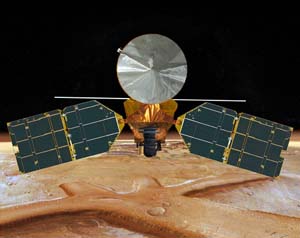A software program developed by researchers at Washington University in St. Louis is allowing viewers access to data and some early images from the most powerful spectral camera ever sent to Mars. The information is now available on NASA’s online planetary data archive.
NASA’s Planetary Data System (PDS) Geosciences Node, housed in the Earth and Planetary Sciences building on the Washington University Danforth Campus, produced the program, the Orbital Data Explorer.
Keith Bennett, of earth and planetary sciences and deputy manager of the PDS Geosciences Node, and software engineer Dan Scholes, put the program together. It is a collection of tools that allows users to search, display and download PDS-archived data from the Mars Reconnaissance Orbiter (MRO) and other selected Mars missions. The program is available at:
http://ode.rsl.wustl.edu/mars/.

Washington University’s Raymond E. Arvidson, Ph.D., James S. McDonnell Distinguished University Professor and chair of earth and planetary sciences in Arts & Sciences, manages the Geosciences Node. The images come from Compact Reconnaissance Imaging Spectrometer for Mars (CRISM), flying aboard NASA’s MRO. The Orbital Data Explorer also provides data sets from the High Resolution Imaging Science Experiment (HiRISE), the Mars Express High Resolution Stereo Camera (HRSC), the Mars Express Observatoire pour la Mineralogie l’Eau, les Glaces et l’Activite (OMEGA) spectrometer, plus gravity data.
CRISM has been searching for mineralogical evidence of past water on the Martian surface since November 2006, when MRO settled into a science-gathering orbit around the planet. CRISM, combined with other cameras and sensors on MRO, is providing the most detailed look yet at Martian geology, climate and surface makeup. Through its telescopic scanners CRISM has taken more than 1,900 images of specific targets, including more than 500 at the instrument’s highest resolution that pinpoints areas down to 15 meters — or 48 feet — in 544 “colors” of reflected sunlight.
The camera has also mapped about half of the planet at lower resolution — showing areas as small as 200 meters (660 feet) in 72 colors — and monitored abundances of atmospheric gases and particulates in the atmosphere, returning more than 950 separate measurements that track seasonal variations.
“The Mars Reconnaissance Orbiter is collecting more data, and carrying out more complex observation plans, than any other mission to Mars,” said Arvidson. “Orbital Data Explorer augments existing tools on the PDS site by providing advanced search, retrieval and order capabilities, as well as integrated analysis and visualization tools that will make it easier to examine and compare data from MRO and other missions.”
Led by scientists at the Johns Hopkins University Applied Physics Laboratory (APL) in Laurel, Md., the CRISM team already has delivered the first display of these observations to the NASA Planetary Data System. They’re available at http://pds-geosciences.wustl.edu/missions/mro/crism.htm, along with several tools that make the data accessible to Web users.
Over its two-year primary mission the orbiter will send back more data than all previous Mars missions combined. This first CRISM package, posted in the Planetary Data System’s Geosciences section, contains about 410 gigabytes of data — enough to fit on nearly 600 compact discs.
“CRISM is opening new areas of discovery on Mars, and uncovering evidence of how water altered the planet over billions of years,” said CRISM Principal Investigator at the APL, Scott Murchie. The APL, which has built more than 150 spacecraft instruments over the past four decades, led the effort to develop, integrate, and test CRISM. The CRISM team includes experts from universities, government agencies and small businesses in the United States and abroad; visit http://crism.jhuapl.edu for more information.
Information about the Mars Reconnaissance Orbiter is available online at http://www.nasa.gov/mro. The Jet Propulsion Laboratory, a division of the California Institute of Technology, manages the mission for the NASA Science Mission Directorate, Washington. Lockheed Martin Space Systems, Denver, is the prime contractor and built the MRO spacecraft.